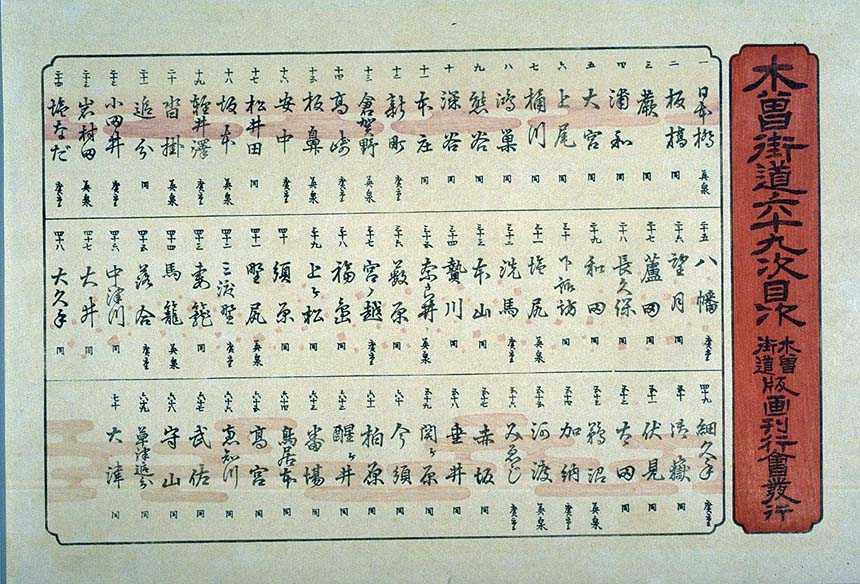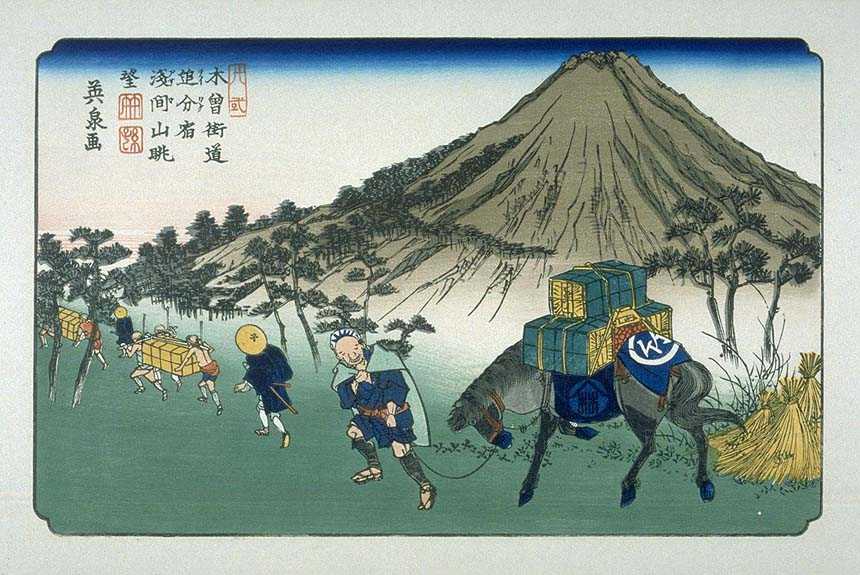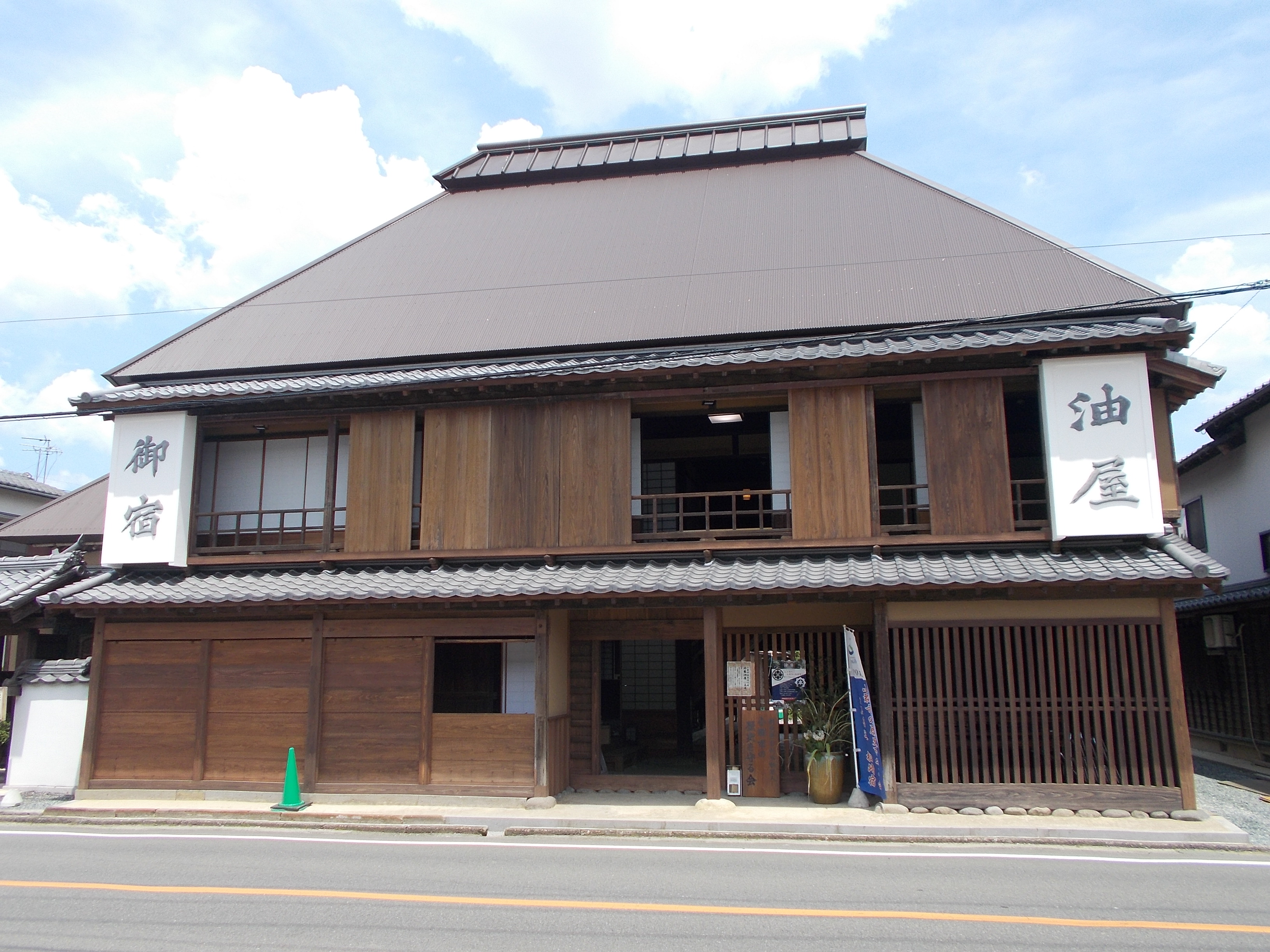|
ŇĆkute-juku
was the forty-seventh of the sixty-nine stations of the NakasendŇć connecting Edo with Kyoto in Edo period Japan. It is located in former Mino Province in what is now part of the city of Mizunami, Gifu Prefecture, Japan. Alternative ''kanji'' for the post town are Ś§ßšĻÖśČč.Nakasendo ŇĆkute-juku Ibisoku Co., Ltd. Accessed July 11, 2007. History ŇĆkute was a settlement on the ancient highway from the , which preceded the construction of the NakasendŇć. Between ŇĆi and ŇĆkute, the road was very narrow and mountainous and goes through 13 passes ( ...[...More Info...] [...Related Items...] OR: [Wikipedia] [Google] [Baidu] |
ŇĆi-juku
was the forty-sixth of the 69 Stations of the NakasendŇć, sixty-nine stations of the NakasendŇć connecting Edo with Kyoto in Edo period Japan. It is located in former Mino Province in what is now part of the city of Ena, Gifu, Ena, Gifu Prefecture, Japan. From ŇĆi-juku to the next post town, ŇĆkute-juku, there are 13 hills to pass over. Travellers using the ShitakaidŇć (šłčŤ°óťĀď) often used ŇĆi-juku, too, as they travelled on to Makiganetsui (śßô„É∂ś†ĻŤŅĹ) afterwards.Nakasendo ŇĆi-juku Ibisoku Co., Ltd. Accessed July 11, 2007. History ŇĆi-juku is located in the southern foothills of the Japanese Alps, near the banks of the Agi River.NakasendŇć ŇĆi ...[...More Info...] [...Related Items...] OR: [Wikipedia] [Google] [Baidu] |
Hosokute-juku
was the forty-eighth of the sixty-nine stations of the NakasendŇć connecting Edo with Kyoto in Edo period Japan. It is located in former Mino Province in what is now part of the city of Mizunami, Gifu Prefecture, Japan.Nakasendo Hosokute-juku . Ibisoku Co., Ltd. Accessed July 11, 2007. History In the early , the system of post stations on the NakasendŇć was formalized by the in 1602. The route between |
The Sixty-nine Stations Of The Kiso KaidŇć
The or ''Sixty-nine Stations of the Kiso Road'', is a series of ''ukiyo-e'' works created by Utagawa Hiroshige and Keisai Eisen. There are 71 total prints in the series (one for each of the 69 shukuba, post stations and Nihonbashi; Nakatsugawa-juku has two prints). The common name for the KisokaidŇć is "NakasendŇć" so the series is sometimes referred to as the ''Sixty-nine Stations of the NakasendŇć''. It is a follow-up to Hiroshige's ''The Fifty-three Stations of the TŇćkaidŇć'' and he produced 47 of the prints, with Eisen being responsible for the rest.Hiroshige - Kisokaido www.hiroshige.org.uk. Accessed November 1, 2017. The series was published by Iseya Rihei (KinjudŇć) from .Forrer The NakasendŇć The NakasendŇć was one of the Edo Five Routes, Five Routes con ...[...More Info...] [...Related Items...] OR: [Wikipedia] [Google] [Baidu] |
Mizunami, Gifu
city located in Gifu Prefecture">Gifu, Japan. , the city had an estimated population of 37,705, and a population density of 220 persons per km2. The total area of the city was . Mizunami's biggest claim to fame came in 1995, when the largest ceramic plate in the world, as recognised by the Guinness Book of Records, was created by the Inatsu Town Planning Association in the city. It measures 2.8 metres in diameter. Geography Mizunami is located in south-eastern Gifu Prefecture. The Kiso River and the Toki River flow through the city. Climate The city has a climate characterized by characterized by hot and humid summers, and mild winters (K√∂ppen climate classification ''Cfa''). The average annual temperature in Mizunami is 14.8 ¬įC. The average annual rainfall is 1928 mm with September as the wettest month. The temperatures are highest on average in August, at around 27.2 ¬įC, and lowest in January, at around 3.0 ¬įC. Neighbouring municipalities *Aichi Pref ... [...More Info...] [...Related Items...] OR: [Wikipedia] [Google] [Baidu] |
Shukuba
were Stage station, staging post stations during the Edo period in Japan, generally located on one of the Edo Five Routes or one of its sub-routes. They were also called ''shuku-eki'' (ŚģŅťßÖ). These stage stations, or "" developed around them, were places where travelers could rest on their journey around the nation. They were created based on policies for the transportation of goods by horseback that were developed during the Nara period, Nara and Heian period, Heian periods. History These stations were first established by Tokugawa Ieyasu shortly after the end of the Battle of Sekigahara. The first stations were developed along the TŇćkaidŇć (road), TŇćkaidŇć (followed by stations on the NakasendŇć and other routes). In 1601, the first of the TŇćkaidŇć's 53 Stations of the TŇćkaidŇć, fifty-three stations were developed, stretching from Shinagawa-juku in Edo to ŇĆtsu-juku in ŇĆmi Province. Not all the post stations were built at the same time, however, as the last one was bui ... [...More Info...] [...Related Items...] OR: [Wikipedia] [Google] [Baidu] |
DaimyŇć
were powerful Japanese magnates, feudal lords who, from the 10th century to the early Meiji era, Meiji period in the middle 19th century, ruled most of Japan from their vast hereditary land holdings. They were subordinate to the shogun and nominally to the Emperor of Japan, emperor and the ''kuge'' (an aristocratic class). In the term, means 'large', and stands for , meaning 'private land'. From the ''shugo'' of the Muromachi period through the Sengoku period to the daimyo of the Edo period, the rank had a long and varied history. The backgrounds of daimyo also varied considerably; while some daimyo clans, notably the MŇćri clan, MŇćri, Shimazu clan, Shimazu and Hosokawa clan, Hosokawa, were cadet branches of the Imperial family or were descended from the ''kuge'', other daimyo were promoted from the ranks of the samurai, notably during the Edo period. Daimyo often hired samurai to guard their land, and paid them in land or food, as relatively few could afford to pay them i ... [...More Info...] [...Related Items...] OR: [Wikipedia] [Google] [Baidu] |
Stations Of The NakasendŇć
Station may refer to: Agriculture * Station (Australian agriculture), a large Australian landholding used for livestock production * Station (New Zealand agriculture), a large New Zealand farm used for grazing by sheep and cattle ** Cattle station, a cattle-rearing station in Australia or New Zealand **Sheep station, a sheep-rearing station in Australia or New Zealand Communications * Radio communication station, a radio frequency communication station of any kind, including audio, TV, and non-broadcast uses ** Radio broadcasting station, an audio station intended for reception by the general public ** Amateur radio station, a station operating on frequencies allocated for ham or other non-commercial use ** Broadcast relay station ** Ground station (or Earth station), a terrestrial radio station for extraplanetary telecommunication with satellites or spacecraft ** Television station * Courier station, a relay station in a courier system ** Station of the ''cursus publicus'', a s ... [...More Info...] [...Related Items...] OR: [Wikipedia] [Google] [Baidu] |
Ukiyo-e
is a genre of Japanese art that flourished from the 17th through 19th centuries. Its artists produced woodblock printing, woodblock prints and Nikuhitsu-ga, paintings of such subjects as female beauties; kabuki actors and sumo wrestlers; scenes from history and folk tales; travel scenes and landscapes; Flora of Japan, flora and Wildlife of Japan#Fauna, fauna; and Shunga, erotica. In 1603, the city of Edo (Tokyo), Edo (Tokyo) became the seat of the ruling Tokugawa shogunate. The class (merchants, craftsmen and workers), positioned at the bottom of Four occupations, the social order, benefited the most from the city's rapid economic growth. They began to indulge in and patronize the entertainment of kabuki theatre, geisha, and oiran, courtesans of the YŇękaku, pleasure districts. The term ('floating world') came to describe this hedonistic lifestyle. Printed or painted ukiyo-e works were popular with the class, who had become wealthy enough to afford to decorate their homes wit ... [...More Info...] [...Related Items...] OR: [Wikipedia] [Google] [Baidu] |
Utagawa Hiroshige
or , born AndŇć TokutarŇć (; 1797 ‚Äď 12 October 1858), was a Japanese ''ukiyo-e'' artist, considered the last great master of that tradition. Hiroshige is best known for his horizontal-format landscape series '' The Fifty-three Stations of the TŇćkaidŇć'' and for his vertical-format landscape series '' One Hundred Famous Views of Edo''. The subjects of his work were atypical of the ''ukiyo-e'' genre, whose typical focus was on beautiful women, popular actors, and other scenes of the urban pleasure districts of Japan's Edo period (1603‚Äď1868). The popular series '' Thirty-six Views of Mount Fuji'' by Hokusai was a strong influence on Hiroshige's choice of subject, though Hiroshige's approach was more poetic and ambient than Hokusai's bolder, more formal prints. Subtle use of color was essential in Hiroshige's prints, often printed with multiple impressions in the same area and with extensive use of '' bokashi'' (color gradation), both of which were rather labor-intensive ... [...More Info...] [...Related Items...] OR: [Wikipedia] [Google] [Baidu] |
Machiya
are traditional wooden townhouses found throughout Japan and typified in the historical capital of Kyoto. ('townhouses') and ('farm dwellings') constitute the two categories of Japanese vernacular architecture known as ('folk dwellings'). originated as early as the Heian period and continued to develop through to the Edo period and even into the Meiji period. housed urban merchants and craftsmen, a class collectively referred to as ('townspeople'). The word is written using two kanji: and or , depending on the kanji used to express it. in Kyoto, sometimes called , formed the defining characteristic of downtown Kyoto architecture for centuries,Kyoto Center for Community Collaboration (šļ¨ťÉĹŚłāśôĮŤ¶≥„ÉĽ„Āĺ„Ā°„Ā•„ĀŹ„āä„āĽ„É≥„āŅ„Éľ)(eds.) ''Machiya Revival in Kyoto'' (šļ¨ÁĒļŚģ∂„ĀģŚÜćÁĒü). Kyoto: Kyoto Center for Community Collaboration, 2008. p10. representing the standard defining form of the throughout the country. The typical Kyoto is a long wooden home with ... [...More Info...] [...Related Items...] OR: [Wikipedia] [Google] [Baidu] |
Hatago
were Edo period lodgings for travelers at ''shukuba'' (post stations) along the national highways, including the Edo Five Routes and the subroutes. In addition to a place to rest, ''hatago'' also offered meals and other foods to the travelers. They were also called . Name origin ''Hatago'' means "traveling basket." The word itself originally derived from baskets that contained food for horses and were carried by travelers. From there, it became a tool with which travelers were carry their own food and goods. Shops that began preparing and selling food for travelers gained the suffix , meaning "shop," but this was eventually shortened to just ''hatago''. Preserved ''hatago'' Because many post stations along the TŇćkaidŇć, NakasendŇć The , also called the ,Richard Lane, ''Images from the Floating World'' (1978) Chartwell, Secaucus ; pg. 285 was one of the centrally administered Edo Five Routes, five routes of the Edo period, and one of the two that connected the ''de facto'' ... [...More Info...] [...Related Items...] OR: [Wikipedia] [Google] [Baidu] |
Honjin
image:Ohara-juku01s3200.jpg, The ''honjin'' at Inaba KaidŇć's ŇĆhara-shuku. is the Japanese word for an inn for government officials, generally located in post stations (''shukuba'') during the later part of the Edo period. Evolution of ''Honjin'' Originally, ''honjin'' were places from which generals directed battles and, therefore, were fleeting in nature. However, as commanders began to transform the ''honjin'' into temporary lodgings during battle and travel, ''honjin'' came to be places where ''daimyŇć'' and other representatives of the shogunate, including ''hatamoto'', ''monzeki'', etc., were allowed to stay during their travels. Many of the ''honjin'' were actually personal residences of village and town leaders. As such, they received official designations from the government and expanded their residences to include walls, gates and other features. Because of their cooperation, the owners of the ''honjin'' also gained various special rights. General travelers, regardless ... [...More Info...] [...Related Items...] OR: [Wikipedia] [Google] [Baidu] |





